Microsoft 365 Copilot Readiness Assessment: Maximise Your AI Investment
Maximise your AI investment with a Microsoft 365 Copilot readiness assessment. Identify key requirements and optimise your Copilot. Start today!
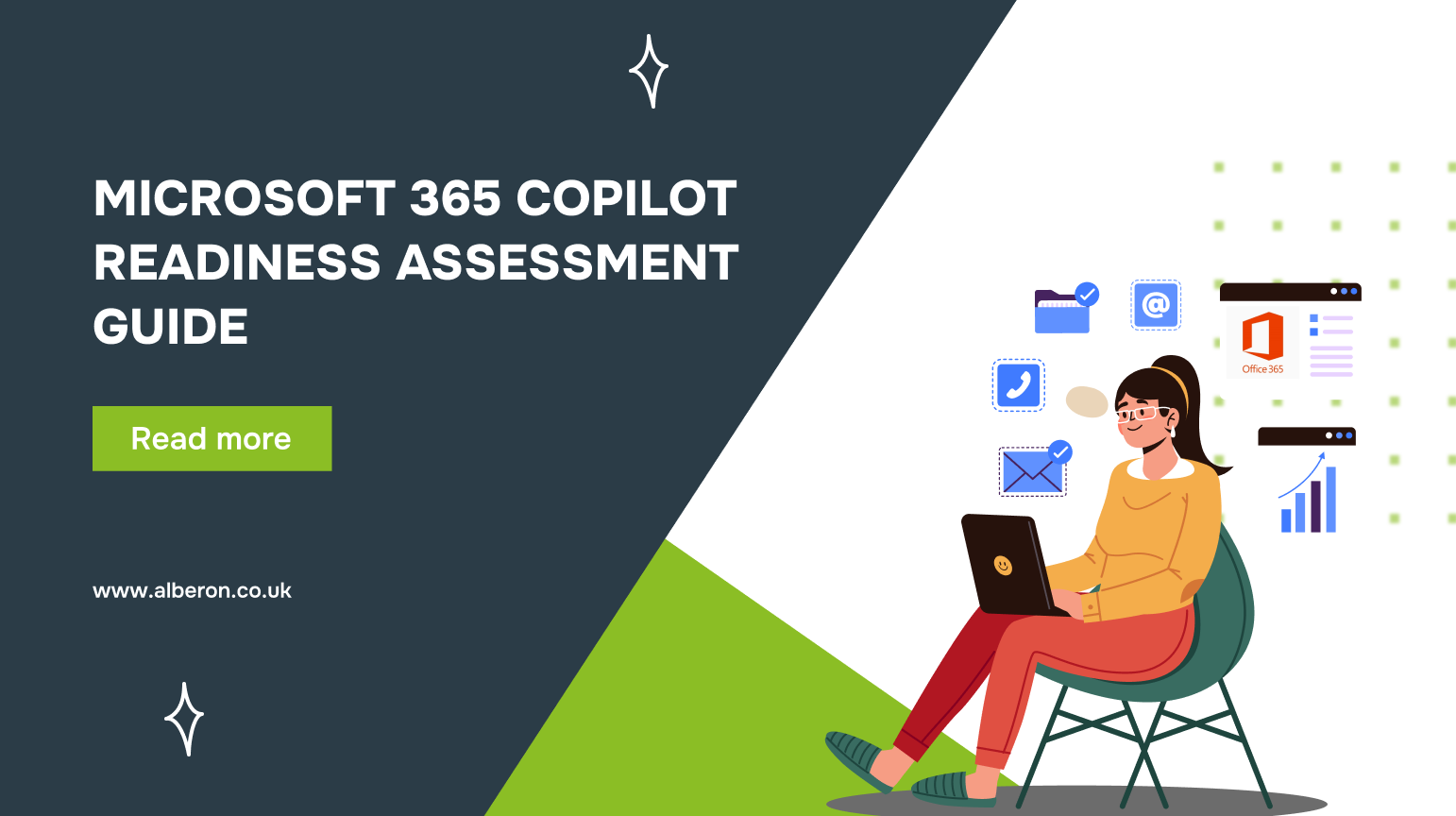
Is your organisation struggling to unlock the full potential of Microsoft 365 Copilot? While it promises enhanced productivity, many businesses face challenges in effectively integrating Copilot into their operations. Without proper readiness, you risk underutilising the tool and missing out on significant cost-saving opportunities.
Studies show that 51% of businesses using Copilot experienced a 1% to 10% reduction in supply chain costs, and 59% saw a decrease in operating costs by up to 20%.
This blog will guide you through the importance of a Copilot readiness assessment and how it helps maximise your investment in Microsoft 365 Copilot.
TL;DR
- Microsoft 365 Copilot Readiness Assessment ensures smooth deployment by evaluating systems, security, and user readiness.
- Key steps include assessing infrastructure, identifying gaps, and optimising workflows for successful integration.
- Alberon offers tailored support to maximise Copilot’s benefits and streamline the deployment process.
- Completing the assessment improves efficiency, user adoption, and compliance.
What is Microsoft 365 Copilot Readiness Assessment, and Why do You Need it?
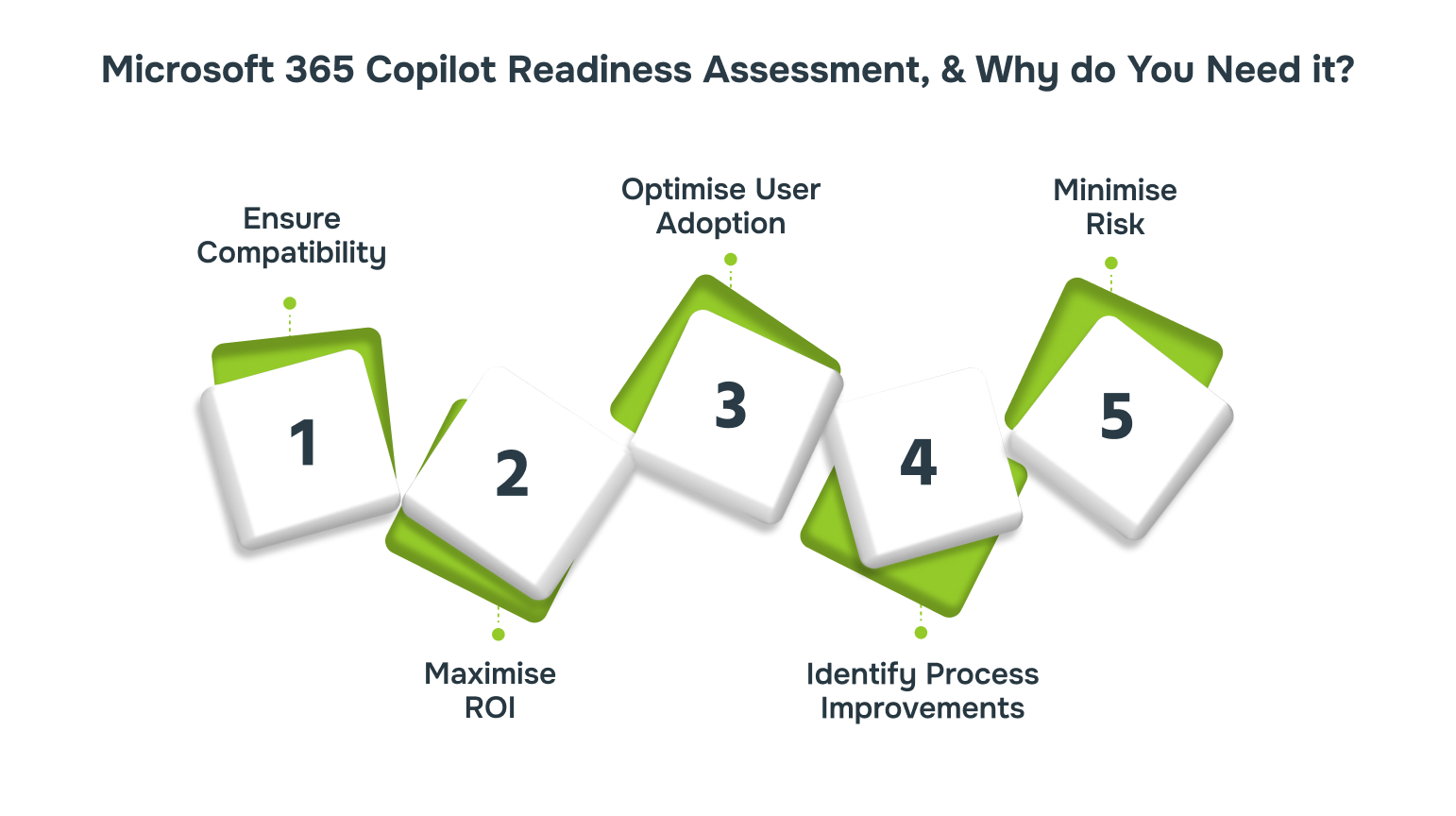
A Microsoft 365 Copilot Readiness Assessment evaluates your organisation’s current setup and prepares it for the seamless integration of Copilot. It helps identify any gaps in licensing, security, and user readiness, ensuring a smoother deployment. This assessment is key to unlocking the full benefits of Copilot.
Without a proper readiness assessment, you risk underutilising Copilot and missing out on its full benefits. Here’s why conducting an assessment is essential:
- Ensure Compatibility: A readiness assessment checks whether your existing Microsoft 365 infrastructure, licenses, and security settings are compatible with Copilot.
- Maximise ROI: By identifying readiness gaps early, the assessment ensures you are fully prepared to realise the maximum return on your investment in Copilot.
- Optimise User Adoption: Copilot’s benefits are directly linked to how effectively your team adopts it. The assessment includes evaluating user training needs and readiness, ensuring a smoother transition.
- Identify Process Improvements: The assessment helps uncover operational inefficiencies that Copilot can address, allowing you to optimise workflows.
- Minimise Risk: Identifying potential issues such as data security before deployment helps mitigate risks, ensuring that your organisation remains secure and compliant.
The Microsoft 365 Copilot Readiness Assessment sets the foundation for a smooth and effective deployment. To successfully perform the assessment, certain preparations are necessary.
What to Prepare Before Performing a Copilot Readiness Assessment?
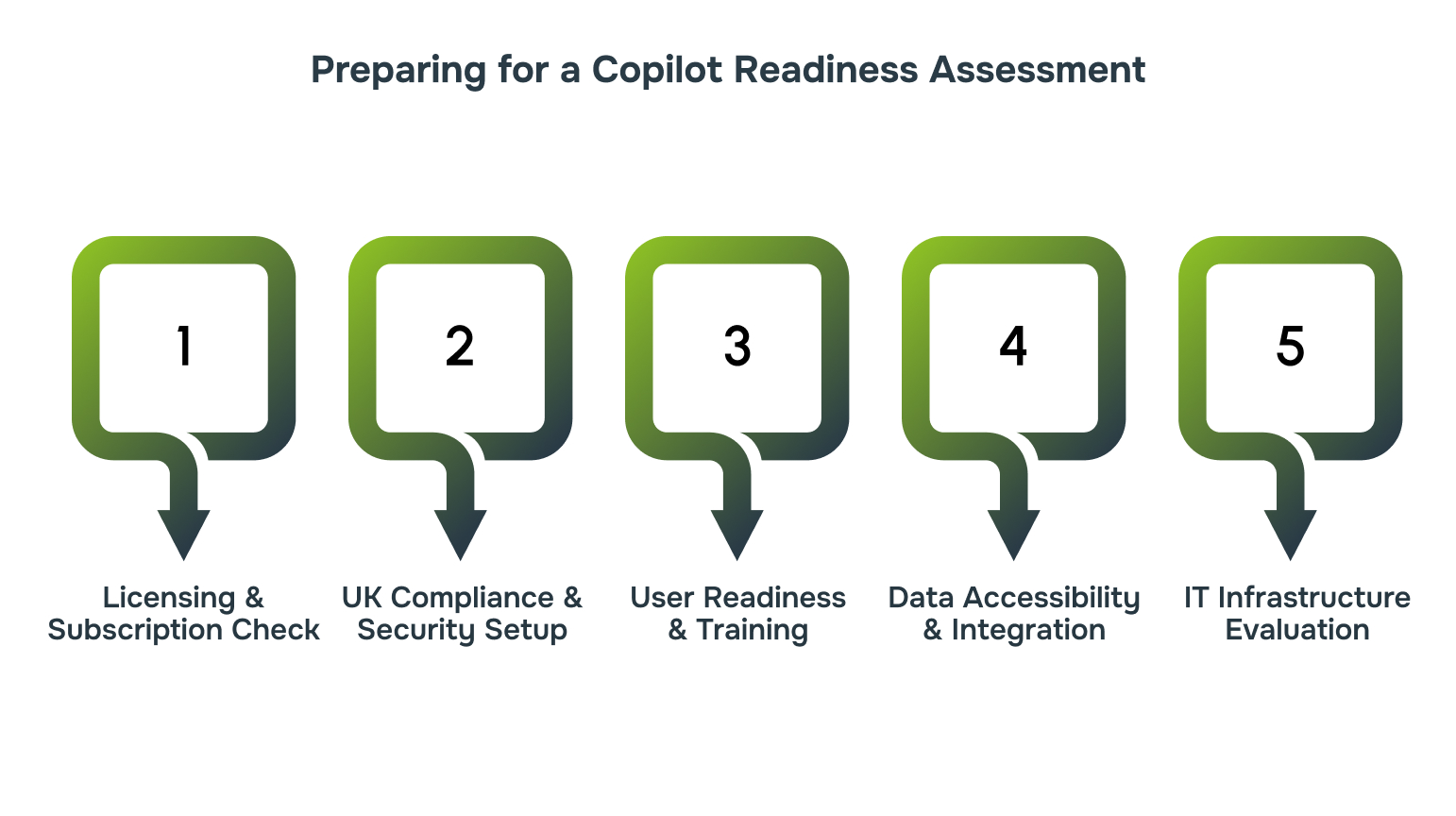
Before conducting a Microsoft 365 Copilot Readiness Assessment, it is essential to align key components of your organisation’s infrastructure. This involves evaluating current systems to ensure they can support Copilot’s features effectively.
With thorough preparation, you can address any potential roadblocks early and ensure seamless integration. Here’s what needs to be in place before performing the readiness assessment:
- Licensing and Subscription Check: Confirm your organisation has the correct Microsoft 365 licences (such as E3 or E5) that include Copilot add-ons. This is a necessary step to ensure Copilot works seamlessly with your existing setup.
- UK Compliance and Security Setup: Ensure your organisation meets UK-specific compliance requirements, such as GDPR and the Data Protection Act 2018. Review your data protection measures, including Microsoft Purview and other compliance tools.
- User Readiness and Training: Evaluate the current level of your team’s familiarity with Microsoft 365 tools. Identify any knowledge gaps and implement a training plan to ensure that employees are ready to use Copilot from day one.
- Data Accessibility and Integration: Make sure your organisation’s data across SharePoint, Teams, and OneDrive is properly indexed and accessible. Copilot needs a seamless connection to these platforms to deliver accurate results.
- IT Infrastructure Evaluation: Review your current IT setup, including network bandwidth and server capacity. Copilot’s AI features can be resource-heavy, so it’s vital your infrastructure can handle the increased demands.
By completing these preparations, you create a solid foundation for a smooth and efficient deployment. With everything in place, the next step is to understand the process involved in performing the Microsoft 365 Copilot Readiness Assessment.
How to Perform Microsoft 365 Copilot Readiness Assessment?
Performing a Copilot Readiness Assessment involves evaluation of your organisation’s systems, processes, and workflows to ensure they are optimally aligned for Copilot deployment. This step-by-step process identifies areas that need improvement, helping you mitigate risks and maximise the benefits of Copilot. Here’s how to approach it:
Step 1: Assess Current Microsoft 365 Environment
Assessing your current Microsoft 365 environment is a crucial first step in preparing for Copilot deployment. This ensures that your existing infrastructure, licenses, and security settings are properly aligned to support Copilot and avoids potential issues later.
- Review your existing Microsoft 365 licenses to ensure they are compatible with Copilot, such as E3 or E5.
- Evaluate user permissions and access controls across Microsoft 365 services, ensuring they align with Copilot’s features.
- Conduct a security audit of your current environment to ensure compliance with data protection laws.
Step 2: Review Data Accessibility and Integration
Ensuring that your data is easily accessible and integrated across Microsoft 365 services is vital for the success of Copilot. Check if your data is properly structured, indexed, and ready to be accessed by Copilot for improved decision-making.
- Verify that key data across platforms like SharePoint, OneDrive, and Teams is indexed and accessible for Copilot.
- Ensure that all necessary files, documents, and conversations are stored in a centralised, accessible location.
- Check data integration between Microsoft 365 apps to ensure Copilot can retrieve and use information from all relevant services.
Step 3: Evaluate User Readiness
Understanding how prepared your team is to adopt Microsoft 365 Copilot is critical for a smooth transition. Evaluate user proficiency with Microsoft 365 tools and identify any gaps that may hinder full Copilot utilisation.
- Conduct a skills assessment to gauge familiarity with Microsoft 365 tools like Teams, Word, Excel, and Outlook.
- Identify users who may need additional training to effectively leverage Copilot’s features.
- Set up pilot groups within your team to test Copilot’s functionalities and gather feedback on user experience.
Step 4: Conduct Security and Compliance Check
Ensuring that your Microsoft 365 environment adheres to security and compliance standards is essential when deploying Copilot. Review your current policies and procedures to guarantee that all data and operations are compliant with regulations.
- Review existing security configurations, including multi-factor authentication (MFA) and data loss prevention (DLP) policies.
- Conduct a compliance audit to confirm that all aspects of Microsoft 365, including data storage and processing, meet UK regulatory standards.
- Ensure that Copilot’s data access and usage are in line with internal security policies and that data privacy is maintained throughout the process.
Step 5: Align IT Infrastructure and Resources
Aligning your IT infrastructure with Microsoft 365 Copilot’s requirements ensures that your systems can support its AI-driven functionalities. Assess whether your current hardware and network setup can handle the additional workload that Copilot may need.
- Evaluate the current network capacity to ensure sufficient bandwidth for Copilot’s AI operations, particularly for tools like Teams.
- Ensure your servers and storage solutions are scalable enough to handle the increase in data processing and retrieval demands with Copilot.
- Confirm that your support staff is adequately equipped to manage the additional tools and features Copilot will introduce to the environment.
Step 6: Perform Functional Compatibility Check
A functional compatibility check ensures that all systems, applications, and services in your Microsoft 365 environment can easily work with Copilot. It helps prevent any disruptions by confirming that existing tools are aligned with Copilot’s capabilities.
- Test Microsoft 365 apps like Word, Excel, and Teams to ensure they integrate smoothly with Copilot’s features.
- Review any third-party apps or custom integrations to confirm compatibility with Copilot, and identify any adjustments needed.
- Conduct tests to ensure that all Copilot functionalities are fully supported across different devices and operating systems in your environment.
Step 7: Identify Potential Gaps and Risks
Identifying gaps and risks early allows for proactive mitigation strategies, ensuring a smoother Copilot deployment. Analyse potential issues that may hinder Copilot’s success and plan for solutions in advance.
- Review limitations in your current systems that could hinder Copilot’s functionality, such as outdated software or hardware.
- Identify any potential security, privacy, or compliance risks associated with the deployment of Copilot.
- Assess the readiness of your team to handle any new challenges or changes that may arise, such as changes in workflows.
Step 8: Develop Copilot Rollout Strategy
A well-defined Copilot rollout strategy ensures that the deployment process is organised, efficient, and aligned with business goals. This ensures a smooth transition and maximisation of its capabilities.
- Create a phased implementation plan, starting with a pilot group and slowly expanding to the entire organisation to gather feedback.
- Define key milestones and timelines for each stage of the rollout, including training, testing, and full deployment.
- Allocate resources to ensure smooth execution at each stage, including dedicated personnel for troubleshooting.
Step 9: Set Metrics for Success
Setting clear, measurable metrics for success helps track the effectiveness of Microsoft 365 Copilot in achieving organisational goals. This can assess Copilot’s impact and identify areas for future improvement.
- Define key performance indicators (KPIs) such as user adoption rates, time saved on tasks, and increased productivity post-deployment.
- Establish baseline data to compare Copilot’s impact, such as current time spent on tasks before Copilot is deployed.
- Implement regular reviews and feedback loops to track progress, allowing for continuous optimisation of Copilot usage.
Ready to optimise your Microsoft 365 Copilot deployment? Contact Alberon today to enhance your data management with our Microsoft SharePoint services and ensure seamless integration across your organisation.
Completing the necessary steps for Copilot readiness helps address key areas such as IT infrastructure and user readiness. Understanding the benefits of completing a Copilot readiness assessment highlights how these steps contribute to long-term success.
Key Benefits of Completing a Copilot Readiness Assessment
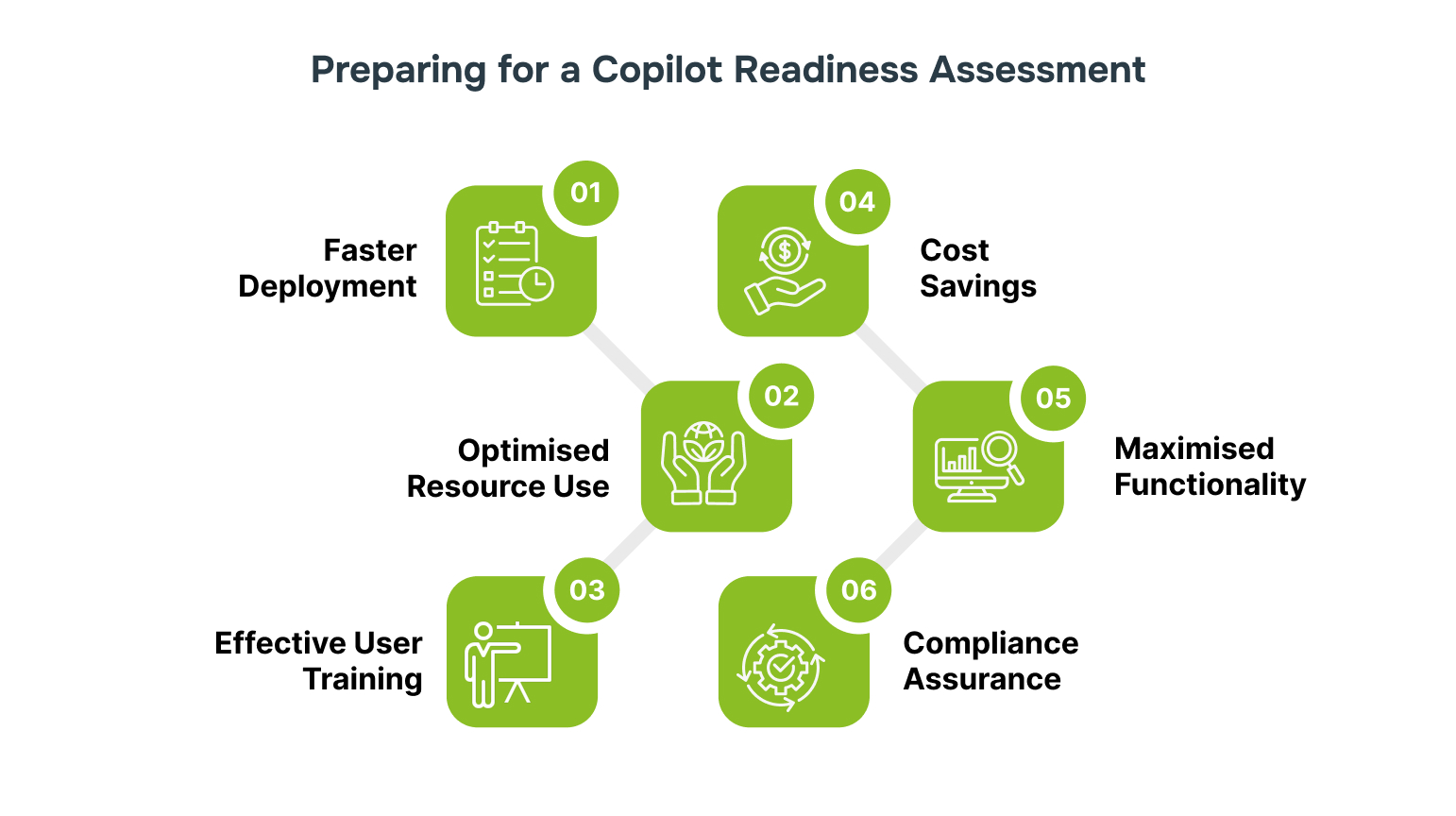
Completing a Microsoft 365 Copilot Readiness Assessment ensures your organisation is set up for a smooth and efficient deployment. It provides a detailed evaluation of your existing systems, workflows, and user readiness, identifying gaps that could hinder Copilot’s effectiveness. Key benefits may include:
- Faster Deployment: Identifying system and process gaps early helps streamline the deployment process.Example: By resolving compatibility issues in advance, you can avoid delays during the Copilot rollout, ensuring faster implementation.
- Optimised Resource Use: Directing resources to areas that need improvement reduces wasted effort.Example: The assessment helps prioritise which departments need additional training or technical support, ensuring resources are allocated effectively.
- Effective User Training: Highlighting specific areas for user training ensures smoother adoption.Example: Identifying knowledge gaps within teams enables you to create targeted training sessions, improving overall user readiness and reducing friction.
- Cost Savings: Addressing potential issues upfront prevents unexpected expenses later in the process.Example: Identifying security gaps early ensures that expensive fixes are avoided during deployment, ultimately saving your organisation money.
- Maximised Functionality: Ensuring Copilot integrates seamlessly with your existing tools optimises its performance.Example: A readiness assessment checks that Copilot works smoothly with tools like SharePoint, enabling full utilisation of its features for greater efficiency.
- Compliance Assurance: Ensuring compliance with UK regulations, such as GDPR, prevents legal issues.Example: Reviewing your organisation’s GDPR compliance during the assessment guarantees that Copilot’s deployment meets data protection requirements.
Completing the readiness assessment ensures your organisation is ready to optimise resource allocation and improve user adoption. With these benefits in mind, it’s important to understand what happens during and after the assessment.
What to Expect During and After a Microsoft 365 Copilot Assessment?
The Copilot Assessment is a structured evaluation that helps you understand the key steps of deployment, offering clarity on what will occur during and after the assessment process. It provides actionable insights into timelines, deliverables, and next steps, so you can effectively plan for Copilot’s integration into your organisation.
Knowing what to expect at each stage allows for a smoother, more predictable rollout.
- During the Assessment:
- Integration Feasibility Study: Review of how Copilot fits into your current workflows, identifying any limitations that might need addressing.
- User Interaction Review: Assessment of how your team uses Microsoft 365 tools, highlighting where Copilot can improve efficiency.
- Customisation and Scalability Analysis: Evaluation of how Copilot can be tailored to your needs and scaled for future growth.
- Risk Mitigation Assessment: Identification of operational and technical risks, with strategies to mitigate potential disruptions.
- After the Assessment:
- Tailored Copilot Roadmap: A step-by-step plan for Copilot’s deployment, customised to your organisation’s goals and timeline.
- Post-Assessment Risk Remediation: Clear recommendations for addressing any risks identified during the assessment.
- Continuous Improvement Recommendations: Insights on how to optimise user adoption and ensure long-term Copilot success.
- Optimisation Strategy for Long-Term Success: A strategic plan for ongoing improvements, system updates, and user feedback to maximise Copilot’s value.
The Copilot Readiness Assessment provides clarity on deployment, but it’s important to recognise that challenges can emerge during the process.
Potential Challenges You May Encounter During Copilot Readiness Assessment
While the Copilot Readiness Assessment helps in smooth integration, several challenges may arise. These challenges can impact business readiness and resource allocation if not addressed early. Recognising and preparing for these obstacles is key to avoiding delays and ensuring successful integration.
| Challenge | Description | Solution |
| System Compatibility Issues | Existing systems may not meet Copilot’s integration requirements. | Perform a pre-assessment to identify and resolve compatibility gaps. |
| Data Access Restrictions | Copilot may have difficulty accessing required data across platforms. | Ensure all data in SharePoint, OneDrive, and Teams is properly indexed and accessible. |
| Adoption Resistance | Employees may be hesitant or slow to adopt Copilot. | Provide targeted user training and clear communication of Copilot’s benefits. |
| Infrastructure Limitations | Current IT infrastructure may struggle with Copilot’s demands. | Assess infrastructure early and invest in any necessary upgrades. |
| Compliance Gaps | Organisation may have non-compliance issues, especially with GDPR. | Conduct a detailed compliance check to meet UK regulations. |
Facing challenges during your Copilot readiness assessment? Alberon’s custom software development services provide tailored solutions to ensure a smooth and successful deployment.
While challenges like system compatibility and data access are common, understanding how other organisations have successfully handled them provides valuable insights.
Examples of Successful Microsoft 365 Copilot Implementations
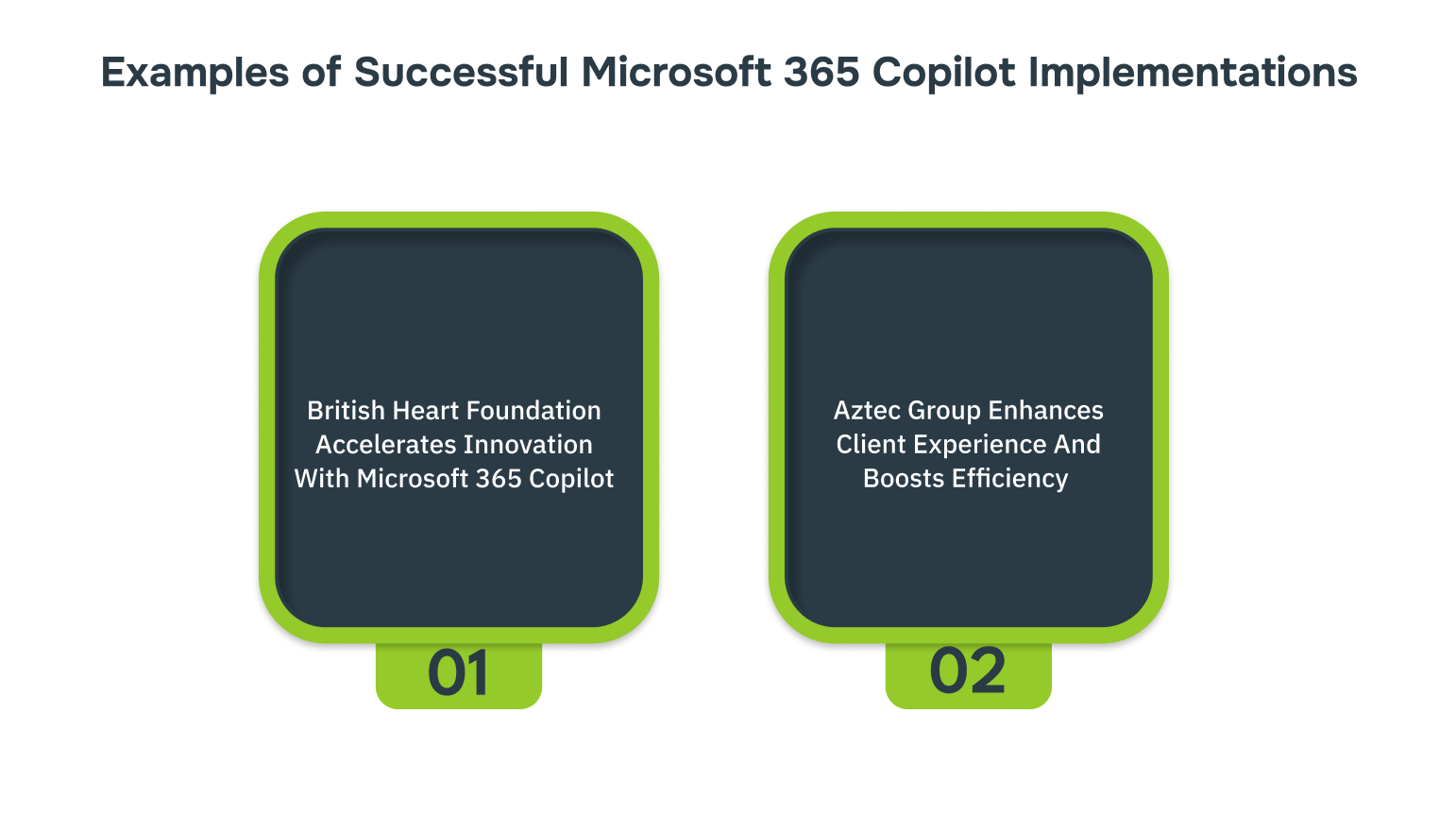
Successful Microsoft 365 Copilot implementations demonstrate the tangible benefits of proper readiness and strategic deployment. These real-world examples provide actionable insights into how businesses can maximise Copilot’s value.
1. British Heart Foundation Accelerates Innovation with Microsoft 365 Copilot
The British Heart Foundation (BHF), Europe’s largest funder of heart and circulatory disease research, faced challenges with administrative tasks and collaboration inefficiencies.
By deploying Microsoft 365 Copilot, BHF streamlined workflows, automated manual tasks, and improved communication.
Post-deployment, staff saved up to 30 minutes per day, allowing them to focus more on mission-critical work instead of routine tasks like report drafting.
2. Aztec Group Enhances Client Experience and Boosts Efficiency
Aztec Group, a global financial services provider, faced challenges managing complex documentation and handling multilingual content across various jurisdictions.
By implementing Microsoft 365 Copilot, Aztec automated workflows, streamlined document creation, and improved client-facing processes.
Post-deployment, Aztec reported significant efficiency gains. Employees were able to save valuable time in document preparation and information retrieval, which allowed them to focus on higher-value tasks.
How Alberon Supports Your Microsoft 365 Copilot Readiness?
Alberon helps optimise your Microsoft 365 Copilot readiness by conducting a detailed audit of your systems and workflows. With practical, hands-on support, Alberon ensures smooth deployment process and realising Copilot’s full potential.
- Customised Microsoft 365 Setup: Alberon customises your Microsoft 365 environment to meet specific business needs, ensuring smooth integration.
- Structured Teams and Channels: Through thoughtful organisation of Teams and Channels, Alberon enhances collaboration.
- Process Automation: With Alberon’s automation solutions, repetitive tasks are streamlined, allowing you to focus on higher-value activities.
- Security and Compliance Setup: Alberon ensures your Microsoft 365 setup adheres to UK data protection regulations.
- Training and Support: Offering ongoing training and support, Alberon equips your team to maximise the effectiveness of Microsoft 365 Copilot.
Conclusion
Incorporating Microsoft 365 Copilot into your business offers a transformative shift in productivity, allowing your teams to operate more intelligently. By enhancing collaboration and streamlining processes, Copilot paves the way for a more connected and data-driven work environment.
Alberon’s tailored approach goes beyond just deployment—we focus on aligning Copilot with your unique business objectives. With our specialised support, we ensure that you maximise Copilot’s potential, driving sustained improvements across your organisation.
If you’re ready to use Microsoft 365 Copilot to transform your business, contact Alberon to discover how our tailored solutions can boost your team’s efficiency and drive growth.
FAQs
Q. What are the technical requirements for implementing Microsoft 365 Copilot?
A: To implement Copilot, your organisation needs Microsoft 365 E3 or E5 licenses, alongside a compatible IT infrastructure with adequate bandwidth.
Q. How much does the assessment cost?
A: The cost of the Microsoft 365 Copilot readiness assessment varies based on your organisation’s size and complexity. Contact Alberon for a tailored quote based on your specific needs and the scope of the assessment.
Q. How does Copilot impact data security and compliance?
A: Copilot adheres to Microsoft’s data security policies, ensuring compliance with regulations like GDPR. It operates within the secure boundaries of your Microsoft environment, ensuring sensitive data remains protected during deployment.
Q. Can we start Copilot with a smaller group first?
A: Yes, many organisations choose to pilot Copilot with a select group of users. This allows you to gauge the tool’s impact, gather feedback, and refine deployment strategies before rolling it out company-wide.
Q. What deliverables will we receive after the assessment?
A: After the assessment, you’ll receive a detailed report highlighting system readiness, potential gaps, and actionable recommendations. Additionally, a roadmap for Copilot deployment and a timeline for implementation will be provided.
Get in Touch Today:
Ready to Improve your Business Productivity
Get a trusted partner to navigate your digital transformation. With Alberon, you can ensure a smooth transition, clear communication, and peace of mind.
